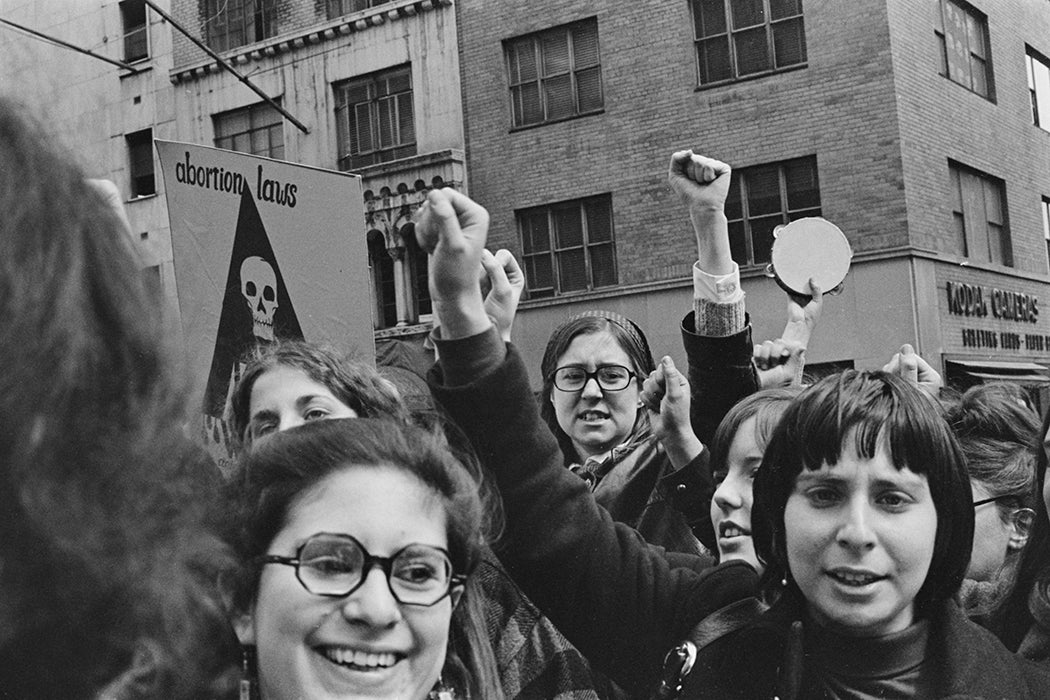Always embattled, women’s reproductive rights once again came under siege in the aftermath of the Supreme Court’s decision in Dobbs v. Jackson Women’s Health Organization. The SCOTUS ruling effectively topples Roe v. Wade, prompting defenders of abortion access to take to the streets as they have for the past five decades.
Thirty years ago, a pending decision in Planned Parenthood v. Casey left activists strategizing how to bolster women’s empowerment. That case, described in 1992 articles including “Is this the end of Roe?” in the ABA Journal, and dissected in the prematurely optimistic “How ‘Planned Parenthood v. Casey’ (Pretty Much) Settled the Abortion Wars” (from a special issue of the Yale Law Journal, 2009), seemed poised to overturn 1973’s Roe v. Wade. Casey’s 5-4 decision, which left abortion access in place, represented a limited victory for reproductive justice. In hindsight, the case chipped away at the constitutional right.
Weekly Newsletter
In the first half of the year, as the Casey decision loomed, grassroots activists in the New York chapter of Women’s Health Action and Mobilization (WHAM) worried about an outcome that would mean the loss of abortion access. I was one of them. Until then, we members of WHAM’s self-help committee had been providing clinic escorts, marching for social justice, and leading activism around breast cancer research and the safety of silicone implants. We determined that in addition to helping people receive care from healthcare providers including clinics, we needed to explore at-home healthcare methods, and we initiated consciousness-raising sessions in our various apartments. Though the underground work of the abortion providers known as the Jane Collective (whose members answered to the Everywoman name Jane in order to conceal their own identities) had ceased with Roe’s passage, we nevertheless imagined a future in which the Janes’ knowledge would become essential once more.
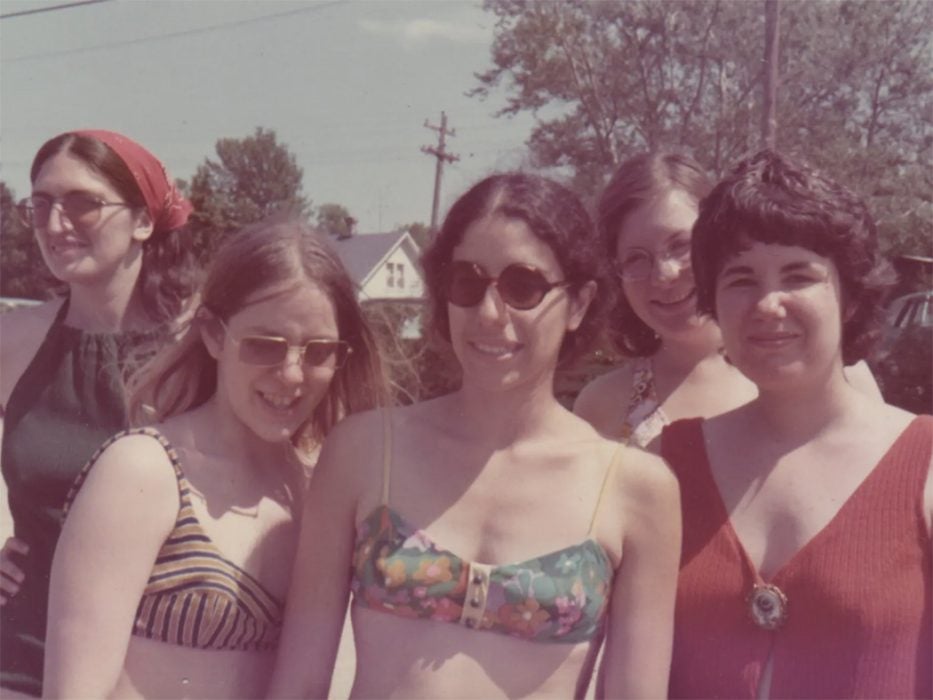
WHAM’s self-help committee ordered copies of two feminist classics from 1981—How to Stay Out of the Gynecologist’s Office and A New View of a Woman’s Body: A Fully Illustrated Guide—plus a box of single-use plastic speculums. Both books had been published by the Federation of Feminist Women’s Health Centers (FFWHC), with anatomical illustrations and earthy images of women’s collectives drawn by artist Suzann Gage; photos by Sylvia Morales showed the naturally diverse appearances of women’s genitalia. Regional feminist zines including Rochester’s New Women’s Times and Milwaukee’s The Amazon celebrated the publication, which augmented canonical women’s-movement staples like the Boston Women’s Health Book Collective’s 1973 Our Bodies, Ourselves. WHAMers learned about menstrual extraction, a process by which the uterine lining is removed at the time of an anticipated or missed period, although we did not have the Del-Em, a device developed by Lorraine Rothman and Carol Downer for the procedure.
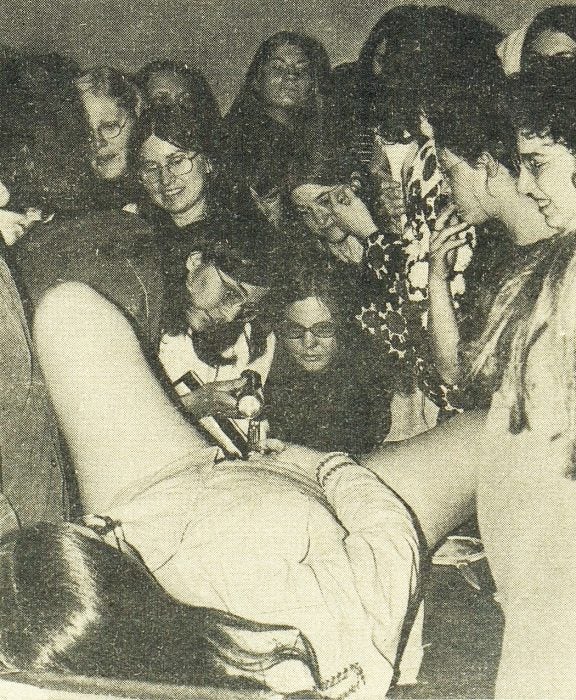
Consulting our books, and armed with speculums, mirrors, and flashlights the group threw what older feminists called a pelvic party—and what Michelle Murphy has referred to as “immodest witnessing”: a collective educational experience. We couldn’t have been more thrilled to learn about changes to cervical mucus and the cervical opening, known as the os, during our regular monthly cycles. We took photos of our cervixes, put them in a poster collage, and took the poster to the April 5, 1992, “We Won’t Go Back” reproductive rights march on the National Mall, an event heralded in off our backs. As we waved our speculums and proclaimed, badly punning, “cervix with a smile,” fellow marchers cheered, while angry counter-protesters lobbed insults and told us we were disgusting. Twentysomethings with a punk sensibility, we were invigorated rather than shamed by the people we scandalized. (Our experience foreshadowed critiques of “offensive” lobbed 18 years later at the academic journal Reproductive Health Matters, which ran a cover image of plaster casts of vulvas on for a special edition on “Cosmetic surgery, body image, and sexuality.”)
We felt like radicals, and we surely were privileged to live in a city where our experiments were not only fun but legal. Yet this formative WHAM moment was part of a practical, if often underground, tradition of in-home healthcare activism and advocacy. For instance, Vaginal Politics author Ellen Frankfort—a feminist who described menstrual extraction procedures in her Village Voice column—appeared in an April 1972 interview about reproductive justice for the University of Wisconsin-Milwaukee, twirling a plastic speculum. Not incidentally, Frankfort’s micro-miniskirt and go-go boots proclaim a 1970s version of women’s liberation. Twenty, and now fifty, years later, Frankfort’s brassy bluntness still feels startling and tough. Everyday women speaking openly about menses, reproductive health, the necessity for abortion access, and freedom in sexuality has never been normalized in the United States.
Suzann Gage likewise became a minor feminist celebrity, thanks to her drawings for the FFWHC texts. Her images, like Frankfort’s directness, offer a surprising view of how people might take care of one another in private spaces. Gage wanted to use her artistic abilities for the women’s movement: she had been an art major and newly out lesbian at Illinois State University, and she became an enthusiastic member of the National Organization for Women (NOW) in its early years. In a 2009 interview with Bonnie Fortune, Gage recalled how her world was rocked when Carol Downer and Lorraine Rothman, early activists in the self-help movement, came to central Illinois in October 1972.
“I was working as a waitress at Town and Country Restaurant in [my Quad-Cities hometown] Rock Island,” Gage said. “It was pouring rain and I had my little black and white uniform on, and my old beat-up Dodge Rambler convertible’s windshield wipers weren’t working.” She hurried to a NOW event, where she heard a talk on vaginal self-examination and watched a documentary in which women demonstrated menstrual extraction and an actual in-home abortion. “Carol [Downer] showed us her cervix, and I … took a speculum home with me,” Gage said. (In the Summer 1978 issue of Quest: A Feminist Quarterly, Lorraine Rothman wrote about menstrual extraction procedures and politics.)
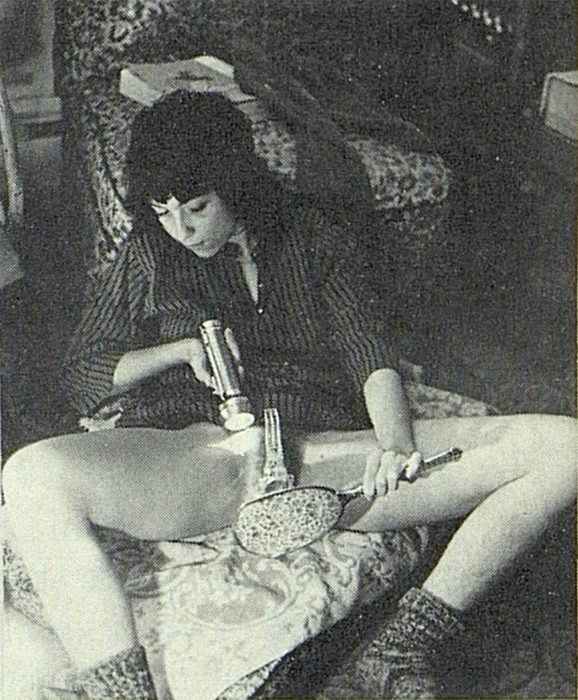
Gage found Downer and Rothman’s forthright activism revelatory. She had never realized people could monitor their own pelvic health without submitting to a clinician’s authority. Shortly after Roe v. Wade made abortion a constitutional right in January 1973, Gage quit school and moved to L.A., where the Feminist Women’s Health Center had formed the Women’s Choice Clinic to provide healthcare services, including outpatient abortions. Gage began creating anatomical illustrations of women’s pelvic anatomy, so that anyone could better understand their reproductive system (including the complex anatomy of the clitoris and urethral sponge, which medical texts have typically failed to represent accurately). She participated in and sketched groups hosting pelvic parties, using her friends and community members as models. She intentionally pictured a diverse range of people participating in their own care, and she focused on women of color due to their historic underrepresentation and vulnerability.
In 1979, Gage published When Birth Control Fails, which she defended in the pages of off our backs after columnist Fran Moira panned the work, calling it “hazardous.” Moira called the practices Gage described “enormously risky and described in vague and misleading terms.” After naming several self-abortion processes and worst-case scenarios, she concluded, “We need to be able to provide ourselves with the means to control our reproductive lives, but right now this manual is more dangerous than helpful.” At the time, Gage felt Moira’s take was “a sarcastic, distorted, sensationalized[,] and at times fallacious representation of self-abortion under the guise of unbiased reportage,” and called the bias against FWHC and self-help “a long oob [off our backs] tradition.” Gage asserted that readers were informed of risk, and that “Moira’s lack of faith in women as reasoning beings (a typical attitude of physicians), is repeated to the extent that one can only read it as ill will.”
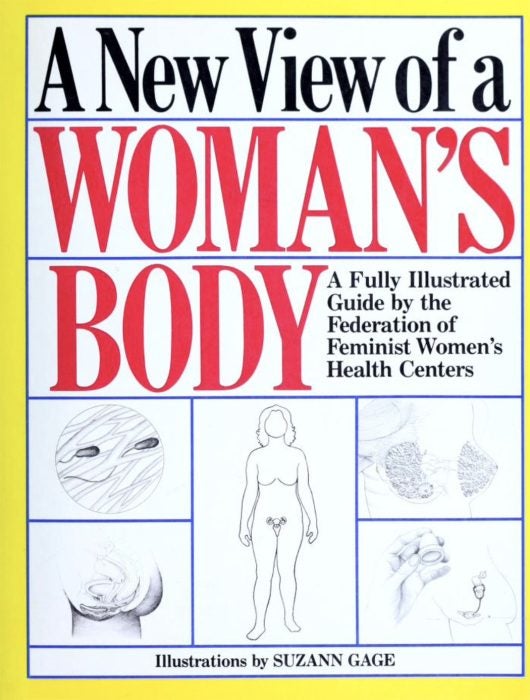
In 1981, Gage and the Federation of Feminist Women’s Health Centers published A New View of a Woman’s Body, which came to be better received than Gage’s previous title. In off our backs, A. J. Fugh-Berman praised the book while critiquing its authors’ editorializing tendencies and a lack of scientific data. Fugh-Berman took care to qualify her statements: “The goal of woman-controlled research is an admirable one. But it is important to keep statistics on success rates, complication rates—not as concession to or mimicry of the medical profession, but for our own use…. If menstrual extraction is indeed a completely benign procedure, then collated data, along with the personal experiences… will constitute a convincing case.” Her review attests to the mistrust feminists felt and still feel toward the biomedical establishment, along with a parallel need for reputable information in grassroots circles. For what it is worth, Gage trained as a nurse practitioner and, in 1985, founded a San Diego clinic that she operates to this day.
The debate among the self-help feminists and off our backs has been taken up in academic discussions around “epistemologies of ignorance.” Feminist philosopher and former Hypatia editor Nancy Tuana writes about the self-help movement as a way to “identify, critique, and transform ignorance.”
“While one aspect of the women’s health movement was to make available to women basic medical knowledge that at that time was accessible only to health-care professionals,” writes Tuana, “an equally important goal of the women’s health movement was to reexamine traditional medicine, not simply in order to ‘get it right,’ but rather to transform our knowledge of women’s bodies so as to remove oppression, to augment women’s lives, and to transform society.” Tuana views bodily autonomy and self-knowledge not only as keys to reproductive justice but as permission to experience sexual pleasure on one’s own terms. In “Coming to Understand: Orgasm and the Epistemology of Ignorance,” she describes ignorance as constructed through societal discourses of “normal” and “deviant” erotic pleasure, including the visual discourses that prioritize reproduction and downplay sexuality in medical textbooks.
From Frankfort, Gage, and Downer in the 1970s and ’80s, to activism in the 1990s, to this century, “autonomous health movements” as Brooklyn College sociologist Naomi Braine calls them, proceed apace, “as forms of collective action that emerge from larger social justice movements to respond to particular health issues in marginalized, criminalized contexts.”
“There is,” she continues,” a globally evolving set of shared practices to assist women with the use of medication for abortion in contexts of limited access.” Braine details global initiatives to spread self-help information for the purpose of harm reduction, initiatives that U.S. activists will be wise to heed in the months ahead.
You Might Like
Medical Mutual Aid Before Roe v. Wade
Notwithstanding decades of self-education among global advocacy groups, whether official or underground, self-help remains a revolutionary practice. Despite the use of tampons and silicone cups during menstruation, access to IUDs and other forms of contraceptive care, and the ability to order mifepristone and misoprostol online (for now), people remain squeamish about pelvic anatomy. As a result, those who have uteruses are often alienated from their own bodies and their own reproductive health. Gage and her community, among many others, invited us to explore our bodies and our health, and moreover to be unembarrassed about them Because of Gage and her fellow travelers, somewhere today, young activists are taking matters into their own hands.
Editor’s note: An earlier version of this story erroneously stated that Carol Downer and Lorraine Rothman were founders of the Jane Collective. We’re grateful to a reader for pointing out the error, which has now been corrected.



